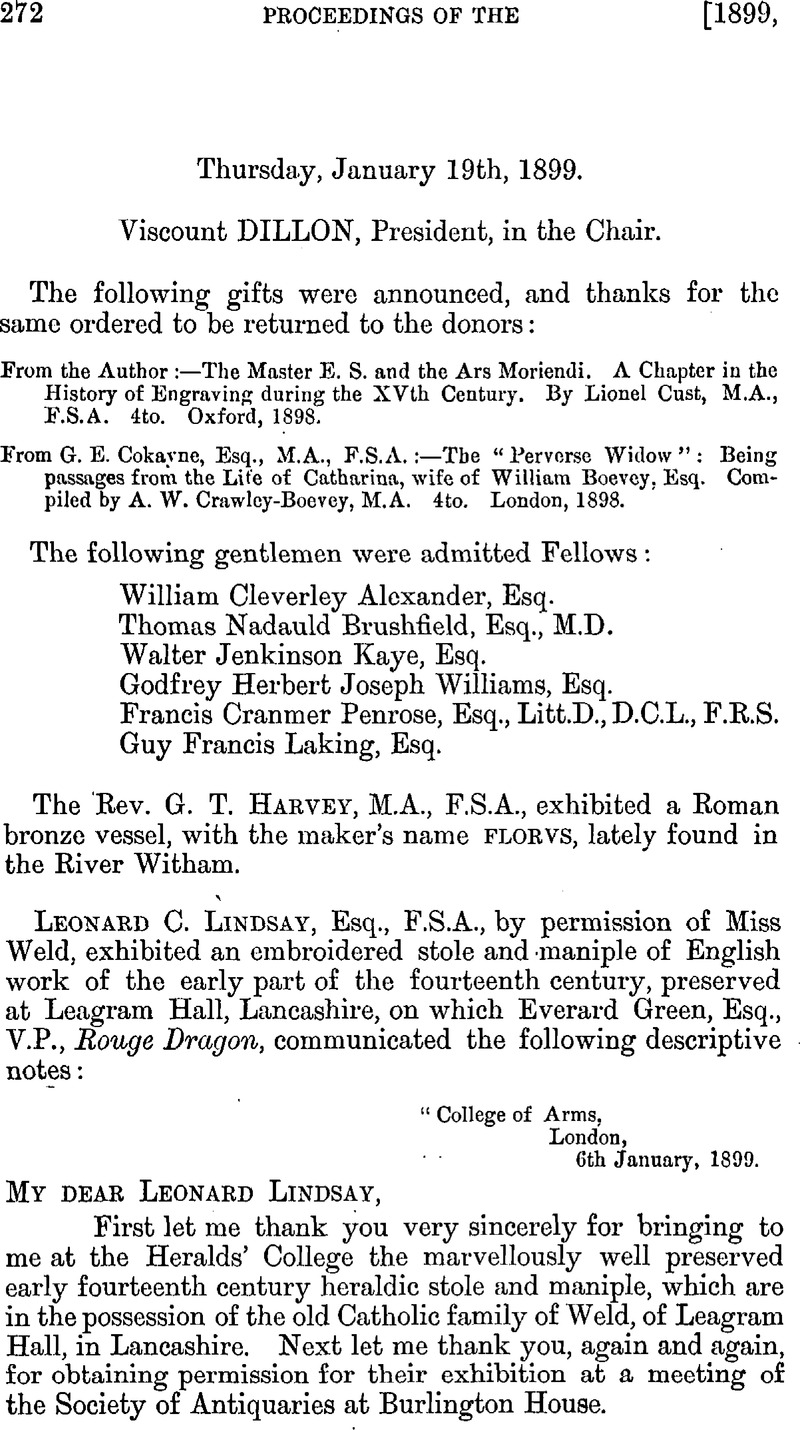No CrossRef data available.
Article contents
Thursday, January 19th, 1899
Published online by Cambridge University Press: 10 May 2010
Abstract

- Type
- Proceedings
- Information
- Copyright
- Copyright © The Society of Antiquaries of London 1899
References
page 274 note * Longstaffe, W. H. D., The Old Heraldry of the Percys (Newcastle, 1860), 14, 15Google Scholar; and Coll. Arms, MS. Dugdale's Yorkshire Arms, f. 88b.
page 281 note * Annual of the British School of Archaeology, 1896–7, p. 170, pi. xiv.
page 284 note * Hill of the Graces, p. 137.
page 284 note † Represented in Photograph VII., 305, in the Hellenic Society's Collection.
page 286 note * Mr. Swainson Cow per compares a double-socketed statue base from a Graeco-Phoenician sanctuary near Athiénu, in Cyprus, described under the name of Golgoi by General L. P. di Cesnola. Cyprus, p. 274. But in that instance the sockets are a good deal deeper, and, besides, the uses of the Cypriote statne base and of the Senam base-blocks are both known, and known to he different. Cf. Ohnefalsch-Richter, Kypros, Pls. v. vi.
page 286 note † In one instance, No. 23 of his list, Mr. Swainson Cowper found two smaller blocks bedded together in place of a single block, and Barth described a Senam at El Keb of which the base is of two graded blocks like the base of a pedestal. Fergusson, Rude Stone Monuments, fig. 176, p. 412.
page 287 note * Mr. Swainson Cowper's measurements are from centre to centre of the holes, and are therefore proportionately larger than those given here, which represent the clear internal between the lower edge of the upper hole, and the upper edge of the lower.
page 287 note † Hill of the Graces, p. 141 ; but his fig. 76 does not seem to bear out his statement.
page 289 note * Rude Stone Monuments, 412.
page 289 note † Journal of Hellenic Studies, xviii. 209, from which, by permission, figures 4–8 are reproduced.
page 289 note ‡ Journal of Hellenic Studies, xviii. 215, fig. 7.
page 289 note § Cf. Journal of Hellenic Studies, xviii. 214, fig. 6. The sixth century leverpress is well illustrated by a Hellenic black-figured skyphos, formerly in the Forman Collection, published in the Forman Sale Catalogue, 1899, No. 323. For this reference I am indebted to Mr. George Clinch.
page 289 note ‖ Represented in Photograph VII. 315, of the Hellenic Society's Collection.
page 291 note * Journal of Hellenic, Studies, xviii. 210–11.
page 291 note † Quarterly Statement of the Palestine Exploration Fund, January, 1899, p. 41.
page 291 note ‡ In the early press on the Forman skyphos (v. note above), the pressure is applied by bags of stones slung on the beam, on which one of the operators also swings himself for extra weight.
page 291 note § Tissot, L'Afrique Romaine, I. 288. Cf. the Maltese example in Caruana, American Journal of Archaeology, iv. 450
page 292 note * Martyn, Antiquities of Herculaneum, pi. xxxv. 1. Monumenti Antichi, vii. 45 (from the house of the Vettii).
page 292 note † Archaeoloyische Zeitung, xxxv. Taf. 7, 1. Baumeister, Denkmäler d. Ant. Kunst, fig 1286.
page 291 note ‡ Furtwängler, Beschreibung der Gesohnittenen Steinen im Antiquarium, No. 8212.
page 293 note * Martyn, Antiquities of Herculaneum, pl. xxxv. 1. Baumeister, Denkmäler fig. 2333. Monumenti Antichi, vii. 45. Cf. the oil press at Stabiae, Tissot, L'Afrique Romaine, 292, figs. 4–7.
page 293 note † Hill of the Graces, fig. 44, p. 232.




